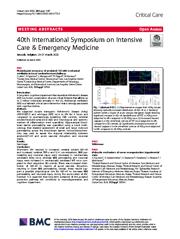40th International Symposium on Intensive Care & Emergency Medicine
2020
Critical Care
Critical Care 2020, 24(Suppl 1):P001 Introduction: A long-term cognitive impairment that resembles Alzheimer's disease (AD) is a known complication of acute critical illnesses that affects up to 2 million individuals annually in the US. Mechanical ventilation (MV) is a hallmark critical care intervention that is strongly associated with cognitive decline. Methods: We subjected double transgenic Alzheimer's disease (Adtg) (APP/PSEN1) and wild-type (WT) mice to MV for 4 hours and compared to
more »
... aneously breathing (SB) controls. Cerebral soluble/insoluble amyloid-β (Aβ) and neurological and systemic markers of inflammation were quantified. Hippocampal bloodbrain barrier permeability was quantified using a novel methodology that enabled assessment of small and large molecule permeability across the blood-brain barrier. Immunohistochemistry was used to assess the regional relationship between amyloid-β1-40 and acute vascular disruption and neuronal injury. Results: See image Conclusions: Short-term MV resulted in increased cerebral soluble Aβ1-40 and increased cerebral TNF-α and IL-6 concentrations. BBB permeability and neuronal injury were decreased in mechanically ventilated ADtg mice, whereas BBB permeability and neuronal injury were increased in mechanically ventilated WT mice compared to their respective SB controls. There was increased distribution of Aβ1-40 in regions of acute vascular disruption, resulting in lower BBB permeability. Overall, these results support a possible physiological role for Aβ1-40 to decrease BBB permeability and neuronal injury during the acute stress of MV, however it is expected that long-term sustained of this putative protective pathway will contribute to neurodegeneration and cognitive impairment. P002 Withdrawn P003 Molecular mechanisms of xenon neuroprotection (experimental data) A Critical Care 2020, 24(Suppl 1):P003 Fig. 1 (abstract P001). (1) Representative images from ADtg mouse showing markedly increased distribution of Aβ1-40 in a "banding" pattern within a region of acute vascular disruption. Graph showing significant increase in Aβ1-40 bands/% area of FITC in ADtg mice subjected to MV compared to SB ADtg mice. (2) Increased cleaved caspase-3 in the entorhinal cortices of WT mice subjected to MV compared to SB controls. (3) Significantly decreased activation of cleaved caspase-3 in the entorhinal cortices of ADtg mice subjected to MV compared to SB ADtg controls Critical Care 2020, 24(Suppl 1):87 which permits unrestricted use, distribution, and reproduction in any medium, provided you give appropriate credit to the original author(s) and the source, provide a link to the Creative Commons license, and indicate if changes were made. The Creative Commons Public Domain Dedication waiver (http://creativecommons.org/publicdomain/zero/1.0/) applies to the data made available in this article, unless otherwise stated. Introduction: The aim of the study was to investigate into the molecular mechanisms of neuroprotection with 50 vol% xenon in an in vivo model experiments. Methods: Eight rats were anesthestized (Combi-Vet machine; induction chloralhydrate 300 mg/kg intraabdominally; then 30 mins of 50 vol% xenon inhalation (95% O2 0.5 l/min, 100% xenon 0.5 l/min; O2 50%, Xe 50%); 8 rats were in the control group (Combi-Vet anesthesia machine; induction chloralhydrate 300 mg/kg intraabdominally; then 30 mins of 95% O2 0.5 l/min). Rats were euthanized and brain homogenates were made. Content of the phosphorylated (inactivated form) of the GSK-3 beta enzyme and key antioxidant enzymes (hemoxygenase, superoxide dismutase, catalase) in rat brain homogenates was assessed by western -immunoblotting. Statistica 6.0, parametric methods were used for data analysis. Results: The research results showed that xenon inhalation anesthesia resulted in a 2-fold increase of the phosphorylated (inactivated form) of the GSK-3 beta enzyme (р<0.05); increased the content of the key antioxidant enzymes (hemoxygenase (by 50%, р<0.05), superoxide dismutase (by 60%, р<0.05), catalase (by 20%, р>0.05) in rat brain homogenates compared to the controls. Conclusions: An increase of the phosphorylated GSK-3 beta enzyme and pool of antioxidant enzymes (hemoxigenase, superoxide dismutase, catalase) in the brain under the xenon anesthesia was proved which suggests a new molecular mechanism for the realization of its neuroprotective properties and has a great clinical outlook. P004 Procalcitonin and C-reactive protein are not increased in ventriculostomy-related infections in patients with hemorrhagic stroke
doi:10.1186/s13054-020-2772-3
pmid:32209112
fatcat:mvoe5mw7cvbrhjs7qmcdirb7ke

